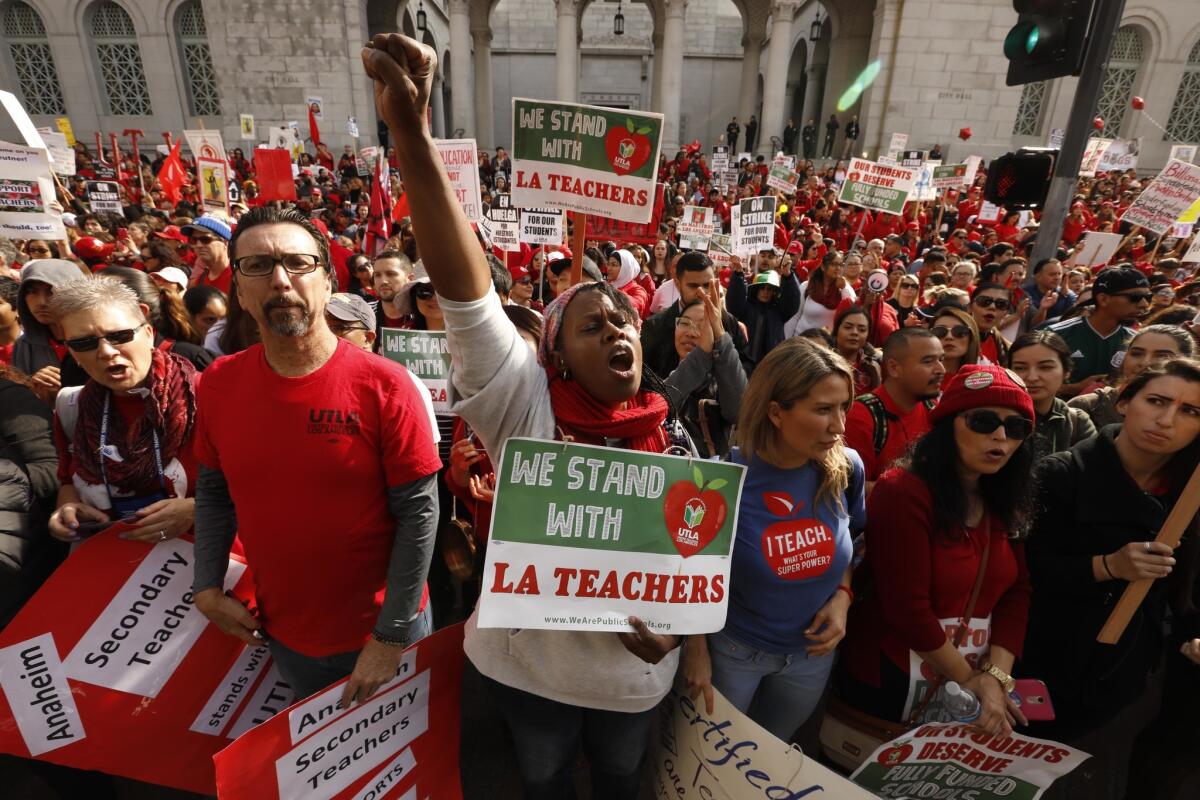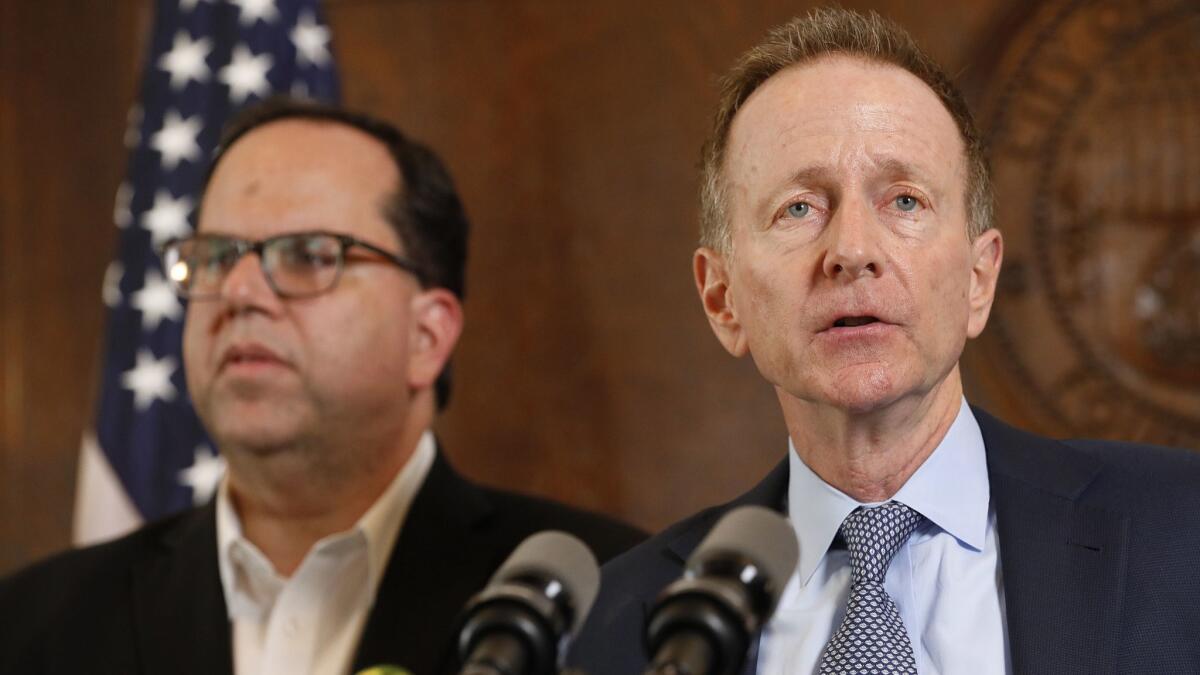Column: Measure EE will cost you a few bucks. Its failure could cost you more

I went to school Tuesday morning.
Saturn Street Elementary is a Mid-City L.A. Unified campus with about 350 students, 80 of them in special-ed classes. The nurse comes only twice a week; same for the school psychologist. As you might have heard, the nationâs second-largest school districtâs got money troubles.
I met in the school library â which is closed two or three days a week â with L.A. Unified Supt. Austin Beutner and teachers union President Alex Caputo-Pearl.
These two strong-willed tough guys have gone at each other like bulls in the past. But the topic of our Tuesday chat was Measure EE, the parcel tax on next weekâs ballot that would provide additional school funding, and the two most powerful people in Los Angeles public education are like a tag team now, practically completing each otherâs sentences.
âReprehensible,â Caputo-Pearl said of the Los Angeles Area Chamber of Commerceâs attack on EE as the wrong answer to a legitimate problem.
âThe chamber said itâs not the answer, so what is?â Beutner chimed in. âIf you think itâs not the answer for kids of poverty and kids of color, I wish the chamber would come to school and say, âWeâre sorry, but we donât think youâre worth a librarian a day.â â
Letâs back up for a minute, though, to January. Thatâs when traffic was stopped in downtown Los Angeles, as thousands of teachers and their allies marched in the rain.
Angelenos roared in support of 600,000 L.A. Unified students and their teachers, and that public cry helped end a six-day strike with promises of higher pay for teachers, smaller class sizes and more support staff.
The people said loud and clear that it is not okay to shortchange schools in which 80% of the students are poor and 90% are minorities, here in a state that ranks at the top in wealth and near the bottom in funding per pupil.
So here we are a few months later, less than a week from an election in which all those school supporters will be asked to put their money where their mouths were.
Measure EE would raise about $500 million annually for L.A. Unified for the next 12 years, paying to retain and attract more teachers, shrink class sizes and fund more nurses, librarians, and other support staff, among other things.
âThe students would love to come in here every day during break time and after school,â said Saturn Principal Tracie Bryant, who briefly joined us in the library. She said a full-time psychologist would help immensely at her school, given the level of trauma many students are dealing with.
Itâs not hard to understand voter weariness over repeated demands for yet another tax to pay for problems that never seem to get solved, especially in the case of a school district that hasnât always been particularly well run. L.A. Unified has agreed to pension and healthcare obligations without budgeting for the cost, itâs been embroiled in more than a few scandals, and declining enrollment means less revenue going forward.
On the other hand, the district has just come up with tens of millions of dollars worth of savings on efficiencies in healthcare costs.

So what would Measure EE cost you?
If you own a 1,500-square foot house youâll pay about $240 a year; twice as much for a house twice that size. About 80% of the revenue would come from commercial, industrial and apartment building owners who might pass the added cost to customers and renters.
Chamber of Commerce President Maria Salinas issued statements criticizing EE for various reasons, including concerns about whether âthe funding sought will actually make it to the classroom.â Unsurprisingly, the chamber would have preferred a flat fee per parcel rather than one based on square footage.
âCry me a river,â Beutner said, imagining a skyscraper owner with a million square feet of floor space who would have to pay a $160,000 parcel tax.
Another opponent of Measure EE is the Howard Jarvis Taxpayers Assn. Thatâs the current incarnation of the movement that brought us Proposition 13, which undercut school funding. California has fallen into the bottom tier of national funding per student when you factor in the cost of living, even while homeowners and commercial property owners have enjoyed strict limits on property tax increases for years.
So in climbing into bed with Jarvis, as the L.A. Chamber has done while complaining about a lack of equity in the structure of Measure EE, itâs not hard to see how the word âreprehensibleâ popped into Caputo-Pearlâs head.
In the Saturn library, Beutner took a napkin and wrote the names of some cities that have taxed themselves to help support local schools: Oakland, San Francisco, Santa Monica, Torrance.
Then he drew a curve and wrote New York City and Boston at one end, with a 23 for the thousands of dollars they spend per pupil. At the other end were Los Angeles, Mississippi and Alabama, where he wrote 16.
âOne of the biggest outcomes of the strike was the awareness that weâre 44th out of 50â in per-pupil funding, said Caputo-Pearl, who thinks the momentum of the strike will carry into next week.
Beutner noted that while the chamber is opposed, business titans, nonprofit executives and university leaders have endorsed EE. Russell Goldsmith, chairman of City National Bank and head of the Los Angeles Coalition for the Economy & Jobs, said Tuesday in a statement that EE âwill help to close the funding shortfalls facing the district and give ⌠Beutner and the school board time to implement much-needed reform.â
âThere are plenty of business leaders supporting EE who get it, and understand that in fact investing in public schools is good for business,â said Caputo-Pearl.
Voters need to ask themselves what happens if Measure EE goes down. Will decades-old buildings deteriorate further, will layoffs be unavoidable, will the students who get a cut-rate education end up costing us more as adults than they contribute?
Measure EE needs two-thirds approval to pass, and thatâs a high bar. The turnout was great in January, though, when supporters of teachers and students marched downtown.
On Tuesday they need to march to the polls.
Get more of Steve Lopezâs work and follow him on Twitter @LATstevelopez
More to Read
Sign up for Essential California
The most important California stories and recommendations in your inbox every morning.
You may occasionally receive promotional content from the Los Angeles Times.










